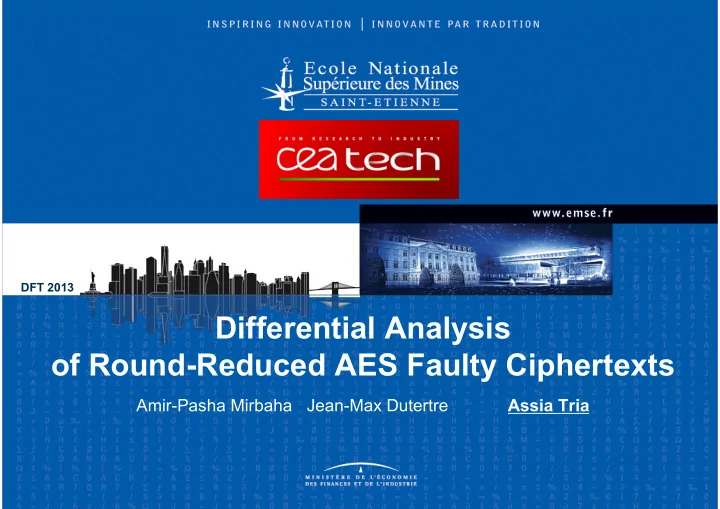

DFT 2013 Differential Analysis of Round-Reduced AES Faulty Ciphertexts Amir-Pasha Mirbaha Jean-Max Dutertre Assia Tria
Outline • Introduction • State-of-the-art of the Round Reduction Analysis • Theory of our attacks and the realizations • Summary and conclusion 2
Introduction AES-128 • is a widely-used symmetric encryption algorithm • includes 10 rounds (after a short initial round) • uses a 128-bit key K and ten derived round keys 3
Problem • Many symmetric cryptographic algorithms are based on the iteration of identical transformation sequences (rounds). • A significant part of these algorithms’ strength against cryptanalysis is based on their iterated rounds. • How much the round reduction attacks are realistic and threatening? Context: Laser fault injection on an unprotected 8-bit 16 MHz 0.35 µ m microcontroller with an embedded AES 4
Fault Injection Means K ¡ Vcc 0 5
Round Reduction Analysis A Round Reduction is an attack for skipping one or several iterative rounds due to a fault injection. A Round Reduction Analysis is a technique for finding the secret key. The technique compares a round-reduced ciphertext to a corresponding reference value (e.g. the corresponnding plaintext or the correct ciphertext). 6
The State-of-the-Art of RRA Three RRA on AES are reported since 2005: They resort to the DFA (Differential Fault Analysis) and use the corresponding plaintext or ciphertext as the reference. • Is there any other potential RR attack and analysis? • Does protecting the two first and the two last rounds suffice to disable the RRA threats? 7
Attack Scenarios R max is a variable in order to select between 128, 192 and 256 versions 8
A General RRA • In theory, two corresponding round-reduced encryptions which differ in only one round may be analyzed in order to reveal the key. The differential analysis requires two texts. • In practice, the analysis is feasible when the Rmax is targeted. However, when the fault is injected into the RC , the encryption includes invalid round key values. Thus, two corresponding round-reduced encryptions which differ in two rounds are needed in order to reveal the key. 9
A General RRA Because, the fault increases the RC to higher than the Rmax value. Thus, the algorithm searches for the invalid key values in the memory. For instance: 10
MicroPackS Laser Bench 11
Summary 12
Conclusion • RR attacks are more realistic and more threatening than what they are usually considered on the unprotected circuit. • They can be carried out at any round by targeting the round- controlling values. • Protecting only the two first and the two last rounds does not suffice to disable the RRA threats. • In this study, we reported our improvement for one former technique and we realized 3 new attacks. 13
Thank you for your attention assia.tria@cea.fr 14
Recommend
More recommend